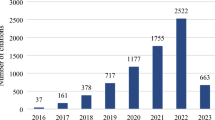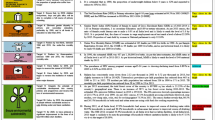Abstract
This paper presents an application of extended goal programming in the field of offshore wind farm site selection. The strategic importance of offshore shore wind farms is outlined, drawing on the case of the United Kingdom proposed round three sites as an example. The use of multi-objective modelling methodologies for the offshore wind farm sector is reviewed. The technique of extended goal programming is outlined and its flexibility in combining different decision maker philosophies described. An extended goal programming model for site selection based on the United Kingdom future sites is then developed and a parametric analysis undertaken at the meta-objective level. The results are discussed and conclusions are drawn.
Similar content being viewed by others
References
Alonso, M., Amaris, H., & Alvarez-Ortega, C. (2012). A multiobjective approach for reactive power planning in networks with wind power generation. Renewable Energy, 37, 180–191.
Banos, R., Manzano-Agugliaro, F., Montoya, F. G., Gil, C., Alcayde, A., & Gomez, J. (2011). Optimization methods applied to renewable and sustainable energy: A review. Renewable & Sustainable Energy Reviews, 15, 1753–1766.
Bevrani, H., & Daneshmand, P. R. (2012). Fuzzy logic-based load-frequency control concerning high penetration of wind turbines. IEEE Systems Journal, 6, 173–180.
Chen, L., & MacDonald, E. (2012). Considering landowner participation in wind farm layout optimization. Journal of Mechanical Design, 134, 084506.
Crown Estate. (2012). Offshore wind cost reduction pathway. Document from Crown Estate. www.thecrownestate.co.uk. Accessed July 7, 2013
Dismukes, D., Upton, G. (2013). Economies of scale, learning effects and offshore wind development costs. Presented at 32nd USAEE/IAEE North American Conference. http://www.usaee.org/usaee2013/submissions/Abs/Dismukes%20Upton%202013.pdf. Accessed on July \(10{\rm th}\), 2014
DECC. (2014). Energy trends section 5: Electricity. UK Department of Energy and Climate Change Report. https://www.gov.uk/government/publications/electricity-section-5-energy-trends. Accessed June \(6{\rm th}\), 2014
DEFRA. (2014) Marine protected areas in the UK. UK Department for Food, Environment and Rural Affairs Report. http://jncc.defra.gov.uk/page-5201. Accessed June \(6{\rm th}\), 2014
Du Pont, B. L., & Cagan, J. (2012). An extended pattern search approach to wind farm layout optimization. Journal of Mechanical Design, 134, 081002.
Ernst & Young. (2009). Cost of and financial support for offshore wind. Ernst & Young report for the Department of Energy and Climate Change, DECC, London. http://webarchive.nationalarchives.gov.uk/+/http:/www.berr.gov.uk/files/file51142.pdf. Accessed on January 16, 2015
Eroglu, Y., & Seckiner, S. U. (2012). Design of wind farm layout using ant colony algorithm. Renewable Energy, 44, 53–62.
Flood, D. (2012). Round 3 offshore wind farms. UK Future Energy Scenarios seminar 2012. Forewind Report. http://www.google.co.uk/url?url=http://www2.nationalgrid.com/WorkArea/DownloadAsset.aspx%3Fid%3D10466&rct=j&frm=1&q=&esrc=s&sa=U&ei=W5yRU5_ZCNKg7AbEyYDIAw&ved=0CEkQFjAH&sig2=oTA_83U-_31DgsFrH7RRZw&usg=AFQjCNGuw68f1p1qjXYeoYF1TDyFHwbk2A. Accessed June \(6{\rm th}\), 2014
Gitizadeh, M., Kaji, M., & Aghaei, J. (2013). Risk based multiobjective generation expansion planning considering renewable energy sources. Energy, 50, 74–82.
Greenacre, P., Gross, R. & Heptonstall, P., (2010). Great expectations: The cost of offshore wind in UK waters. UK Energy Research Centre, London. https://spiral.imperial.ac.uk/bitstream/10044/1/12649/6/Great%20Expectations%20-%20The%20cost%20of%20offshore%20wind%20in%20UK%20waters.pdf. Accessed on January 16, 2015
Heptonstall, P., Gross, R., Greenacre, P., & Cockerill, T. (2012). The cost of offshore wind: Understanding the past and projecting the future. Energy Policy, 41, 815–821.
Jones, D. F., & Jimenez, M. (2013). Incorporating additional meta-objectives into the extended lexicographic goal programming framework. European Journal of Operational Research, 227, 343–349.
Jones, D. F., & Tamiz, M. (2010). Practical goal programming. New York: Springer.
Jones, D. F. (2011). A practical weight sensitivity algorithm for goal and multiple objective programming. European Journal of Operational Research, 213, 238–245.
Kang, M. S., Chen, C. S., Ke, Y. L., Lee, A. H., Ku, T. T., & Kang, H. Y. (2013). Applications of FANP and BOCR in renewable energy-study on the choice of the sites for wind farms. IEEE Transactions on Industry Applications, 49, 982–989.
Kargarian, A., & Raoofat, M. (2011). Stochastic reactive power market with volatility of wind power considering voltage security. Energy, 36, 2565–2571.
Koroneos, C., Xydis, G., & Polyzakis, A. (2013). The optimal use of renewable energy sources: The case of Lemnos Island. International Journal of Green Energy, 10, 860–875.
Kusiak, A., & Song, Z. (2010). Design of wind farm layout for maximum wind energy capture. Renewable Energy, 35, 685–694.
LINDO. (2014). Lingo 14.0—Optimization modeling software for linear, nonlinear and integer programming. Lindo Systems Ltd. http://www.lindo.com/index.php?option=com_content&view=article&id=2&Itemid=10. Accessed July \(17{\rm th}\), 2014
Marine Management Organisation. (2013). UK sea fisheries statistics 2012. A national statistics report. http://www.marinemanagement.org.uk/fisheries/statistics/documents/ukseafish/2012/final.pdf Accessed \(6{\rm th}\) June 2014
Mavrotas, G., Diakoulaki, D., & Capros, P. (2003). Combined MCDA-IP approach for project selection in the electricity market. Annals of Operations Research, 120, 159–170.
Mourmouris, J. C., & Potolias, C. (2013). A multi-criteria methodology for energy planning and developing renewable energy sources at a regional level: A case study Thassos, Greece. Energy Policy, 52, 522–530.
Niknam, T., Zare, M., Aghaei, J., & Azizipanah-Abarghooee, R. (2012). Interactive multiobjective daily volt/var control of distribution networks considering wind power and fuel-cell power plants. Journal of Renewable and Sustainable Energy, 4, 033120.
Ortegon, K., Nies, L. F., & Sutherland, J. W. (2013). Preparing for end of service life of wind turbines. Journal of Cleaner Production, 39, 191–199.
Oxford Economics. (2013). Tourism: Jobs and growth. The economic contribution of the tourism economy in the UK. http://www.visitbritain.org/Images/Final%20proof%2015%20Nov_tcm29-39296.pdf. Accessed June \(6{\rm th}\), 2014
Pertin, E. (2013, October). 2OM project. http://www.2om-project.eu/the-2om-project/. Accessed June \(6{\rm th}\), 2014
Qiao, J. G., Min, Y., & Lu, Z. X. (2006). Optimal reactive power flow in wind generation integrated power system. IEEE International Conferenc Proceedings on Power Systems Technology: POWERCON, 1–6, 928–932.
Ramboll Offshore Wind. (2010). Focus on foundations: Offshore wind conference. Larger wind power stations further offshore & avoid costly delays. Wind Power Monthly, London.
Renewable, U.K. (2012). Wind energy in the UK: State of the industry reports 2012. http://www.renewableuk.com/en/publications/reports.cfm/SOI2012. Accessed on January 16, 2015
Romero, C. (2004). A general structure of achievement function for a goal programming model. European Journal of Operational Research, 153, 675–686.
Saavedra-Moreno, B., Salcedo-Sanz, S., Paniagua-Tineo, A., Prieto, L., & Portilla-Figueras, A. (2011). Seeding evolutionary algorithms with heuristics for optimal wind turbines positioning in wind farms. Renewable Energy, 36, 2838–2844.
Sampaio, H. C., Dias, R. A., & Balestieri, J. A. (2013). Sustainable urban energy planning: The case study of a tropical city. Applied Energy, 104, 924–935.
Sareni, B., Abdelli, A., Roboam, X., & Tran, D. H. (2009). Model simplification and optimization of a passive wind turbine generator. Renewable Energy, 34, 2640–2650.
Stein, E. W. (2013). A comprehensive multi-criteria model to rank electric energy production technologies. Renewable & Sustainable Energy Reviews, 22, 640–654.
Wan, C., Wang, J., Yang, G., Gu, H., & Zhang, X. (2012). Wind farm micro-siting by Gaussian particle swarm optimization with local search strategy. Renewable Energy, 48, 276–286.
Zare, M., & Niknam, T. (2013). A new multi-objective for environmental and economic management of Volt/Var Control considering renewable energy resources. Energy, 55, 236–252.
Zhang, L., & Wirth, A. (2010). Wind energy management with battery storage. Journal of the Operational Research Society, 61, 1510–1522.
Acknowledgments
The authors would like to thank the European Union Interreg IV A (Channel) programme for their funding of this research under the 2OM: Offshore Operations and Maintenance Mutualisation project and the two anonymous referees whose comments have helped enhance the paper.
Author information
Authors and Affiliations
Corresponding author
Rights and permissions
About this article
Cite this article
Jones, D.F., Wall, G. An extended goal programming model for site selection in the offshore wind farm sector. Ann Oper Res 245, 121–135 (2016). https://doi.org/10.1007/s10479-015-1828-2
Published:
Issue Date:
DOI: https://doi.org/10.1007/s10479-015-1828-2




